Howlite is a mineral that is primarily composed of calcium borosilicate hydroxide. It is named after Henry How, a Canadian chemist and geologist who first discovered it in Nova Scotia, Canada, in 1868. Howlite is commonly found in white or grayish-white colors, with a porous and often veined or web-like appearance.
Geologically, howlite is formed in evaporite deposits that result from the alteration of volcanic ash. It typically occurs in association with other minerals such as gypsum, calcite, and quartz. While it is predominantly found in Canada, howlite can also be found in other locations around the world, including the United States, Mexico, Germany, and Russia.
In terms of its historical significance, howlite has been used for centuries by indigenous cultures for its ornamental and spiritual properties. It has been carved into beads, pendants, and decorative objects, and has been incorporated into jewelry and cultural artifacts.
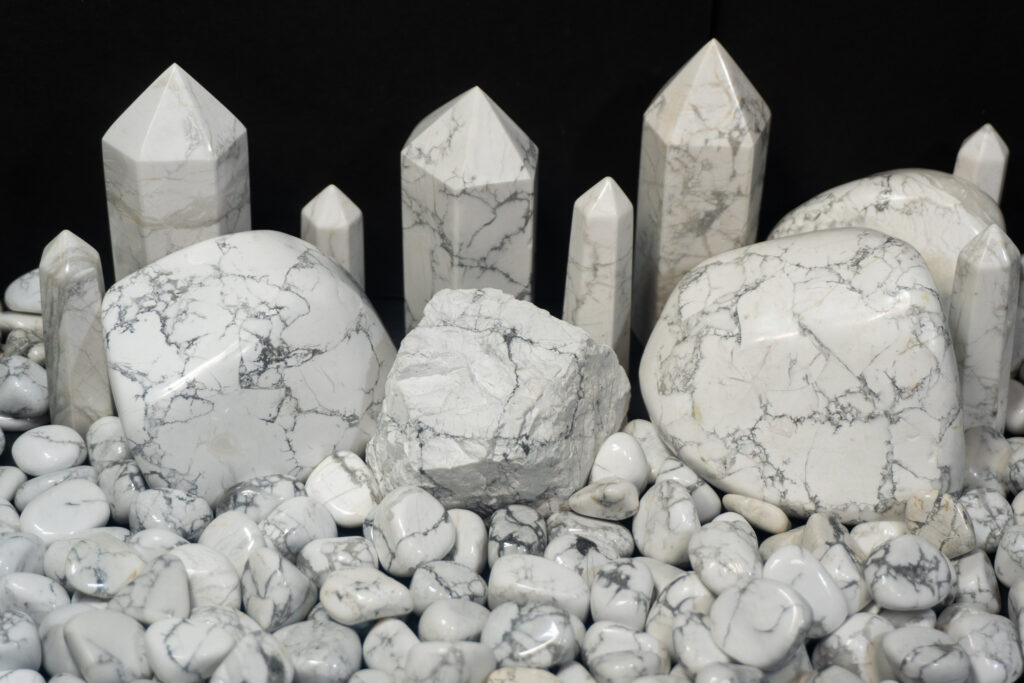
Howlite gained popularity in the 19th century as a substitute for more expensive gemstones like turquoise and coral due to its striking white color and ability to be easily dyed. It has been commonly used in the production of beads, cabochons, and other jewelry components.
In recent years, howlite has gained recognition for its unique appearance and versatile use in jewelry making. It is often incorporated into contemporary and bohemian-style jewelry designs, appreciated for its natural beauty and affordable price compared to precious gemstones.
Whether you are drawn to its visual appeal, its metaphysical properties, or its historical significance, howlite continues to captivate individuals across various cultures and backgrounds. Its distinct appearance and potential benefits make it a fascinating and sought-after mineral in the world of gemstones and jewelry.

Geological formation and occurrence
Howlite is primarily formed in evaporite deposits, which are sedimentary rock formations that result from the evaporation of water containing dissolved minerals. The process of howlite formation involves the alteration of volcanic ash.
When volcanic ash mixes with water, it undergoes a series of chemical reactions. The ash contains various elements, including calcium, boron, silicon, and oxygen. Over time, these elements react with water and other minerals in the surrounding environment, leading to the formation of howlite.
The specific geological conditions necessary for howlite formation include the presence of volcanic activity, volcanic ash deposition, and subsequent exposure to water. The ash must also come into contact with certain elements and minerals that contribute to the chemical reactions responsible for howlite formation.
Howlite is commonly found in association with other minerals, such as gypsum, calcite, and quartz. It can occur as nodules, veins, or masses within the host rock. The mineral often exhibits a porous and veined or web-like appearance, with its characteristic white or grayish-white color.
The primary source of howlite is Canada, particularly in the province of Nova Scotia, where it was first discovered by Henry How. The deposits in Nova Scotia contain significant amounts of howlite, and the mineral has become closely associated with the region.
Howlite is also found in other parts of the world, including the United States (California, Nevada), Mexico, Germany, Russia, and some other countries. However, the Canadian deposits remain the most significant and commercially viable sources of howlite.
Mining is the process by which howlite is extracted from the earth. It involves the excavation and removal of the host rock containing the mineral. Once extracted, howlite is processed and prepared for various applications, such as cutting and polishing for use in jewelry or carving into decorative objects.
Overall, the geological formation of howlite involves a combination of volcanic ash deposition, chemical reactions, and specific environmental conditions. The resulting deposits of howlite have provided a valuable source of this unique and attractive mineral for both practical and aesthetic purposes.
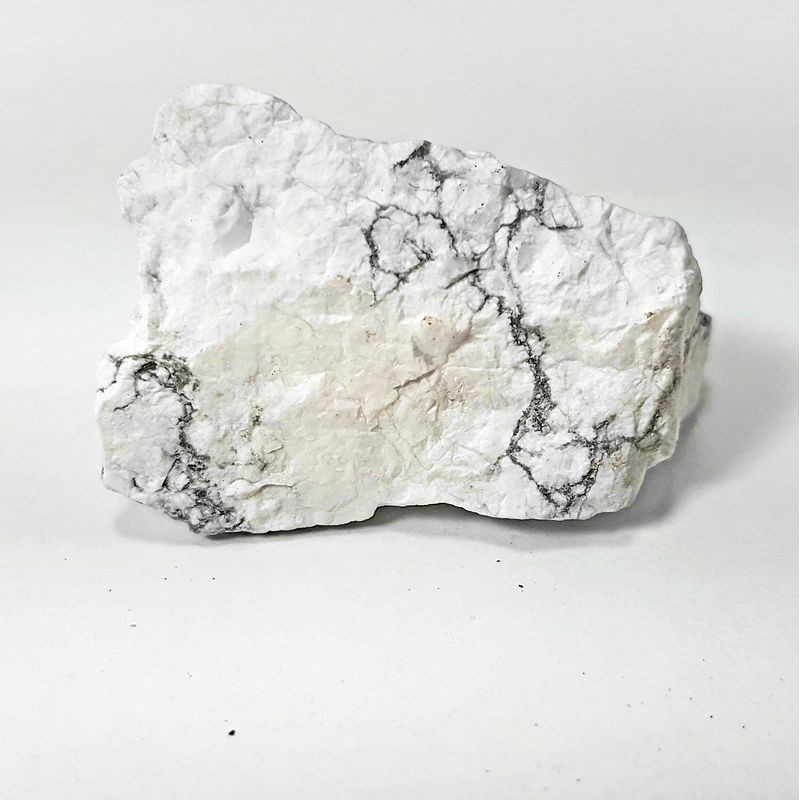
Physical Properties
Howlite possesses several distinctive physical properties that contribute to its identification and unique characteristics. Here are the key physical properties of howlite:
- Color: Howlite is predominantly white or grayish-white in color. It can sometimes exhibit slight variations, with streaks or veining in different shades of gray, black, or brown.
- Luster: Howlite typically displays a vitreous (glassy) to dull luster, depending on its surface quality and finish.
- Transparency: Howlite is usually opaque, meaning it does not allow light to pass through it.
- Crystal system: Howlite crystallizes in the monoclinic crystal system, which means its crystal structure consists of three unequal axes and one oblique axis.
- Hardness: Howlite has a hardness of 3.5 to 6 on the Mohs scale. This range indicates that howlite is a relatively soft mineral, making it susceptible to scratching and abrasion.
- Cleavage: Howlite exhibits perfect cleavage in one direction, which means it can easily split along flat, parallel planes. The cleavage surfaces are typically smooth and can appear as shiny or pearly.
- Fracture: When howlite is broken or fractured, it tends to display a subconchoidal or uneven fracture surface.
- Density: The density of howlite ranges from 2.53 to 2.59 grams per cubic centimeter (g/cm³). This density is slightly higher than the average density of water.
- Porosity: Howlite is known for its porous nature, often displaying small cavities or pore-like structures within its matrix. These pores can sometimes be visible to the naked eye.
- Other characteristics: Howlite is relatively lightweight, exhibits low thermal conductivity, and is not fluorescent under ultraviolet (UV) light.
These physical properties collectively contribute to howlite’s appearance, feel, and durability. Its distinctive color, veining, and porosity make it easily recognizable and sought after for various applications, particularly in jewelry making and ornamental use.
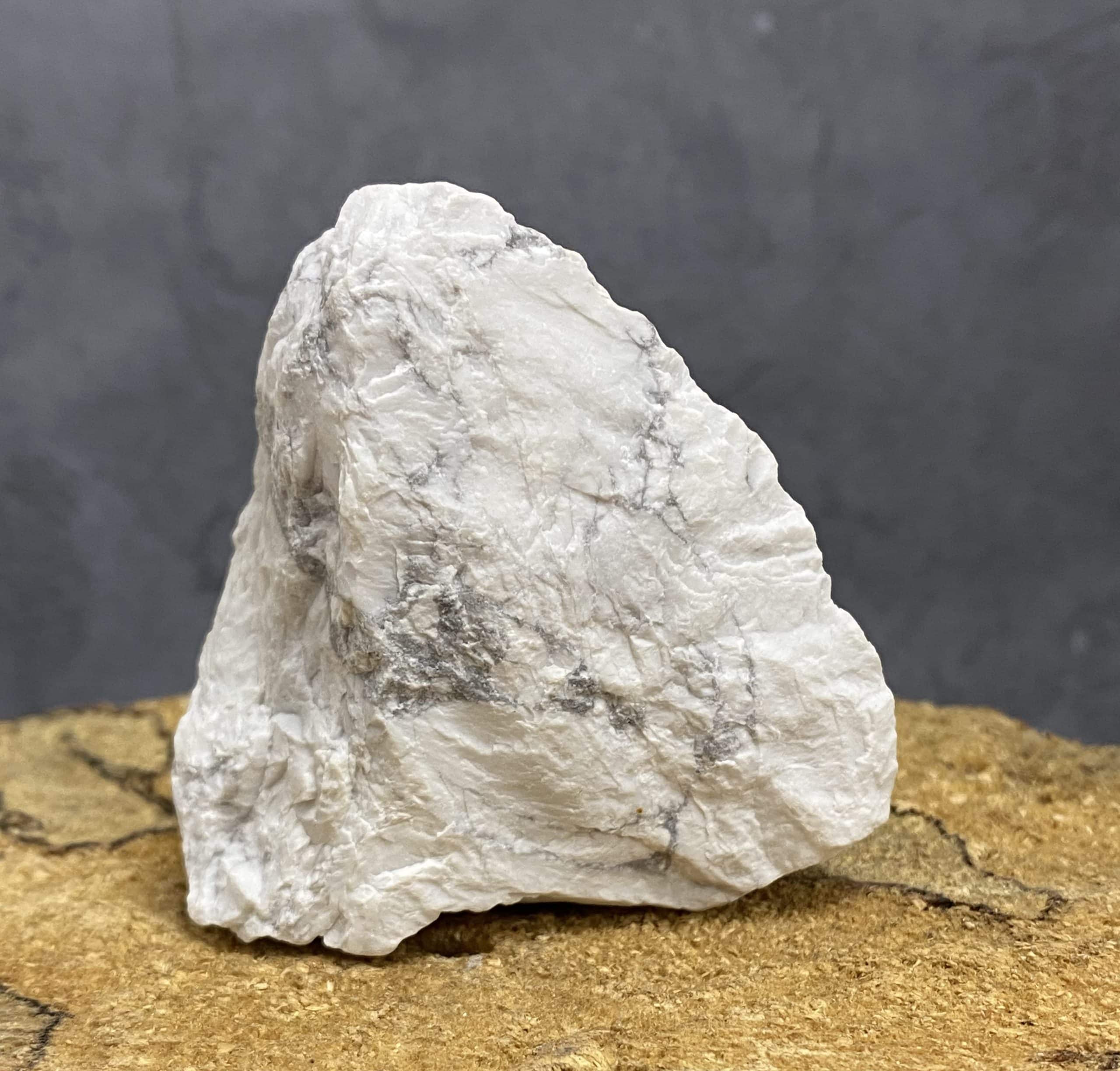
Chemical composition and structure
The chemical composition of howlite is described as a calcium borosilicate hydroxide. Its chemical formula is often written as Ca2B5SiO9(OH)5. Let’s break down the components of the formula:
- Calcium (Ca): Calcium is an essential element in the composition of howlite. It contributes to the mineral’s overall structure and properties.
- Boron (B): Boron is another crucial element found in howlite. It plays a role in the mineral’s chemical composition and can influence its characteristics.
- Silicate (SiO4): Silicate is a combination of silicon (Si) and oxygen (O). It forms a fundamental building block of many minerals, including howlite. Silicate tetrahedra, which consist of one silicon atom bonded to four oxygen atoms, create the structural framework of the mineral.
- Hydroxide (OH): The hydroxide group (-OH) consists of one oxygen atom bonded to one hydrogen atom. It is also a component of howlite’s chemical formula and contributes to its overall composition.
In terms of its structure, howlite crystallizes in the monoclinic crystal system. This crystal system is characterized by three unequal axes and one oblique axis. The arrangement of atoms within the crystal lattice of howlite gives rise to its specific crystallographic properties and symmetry.
The crystal structure of howlite consists of interconnected chains of silicate tetrahedra. These chains run parallel to each other and are linked by calcium and boron atoms, as well as hydroxide groups. The resulting structure forms layers that can be easily cleaved, contributing to howlite’s perfect cleavage in one direction.
It’s important to note that while howlite’s chemical composition and structure are relatively consistent, there can be variations in trace elements and impurities present, which may lead to slight variations in physical properties or appearance.
Understanding the chemical composition and structure of howlite helps to explain its unique properties and contributes to its identification as a distinct mineral species.

Optical Properties
The optical properties of howlite describe how the mineral interacts with light. Here are the key optical properties of howlite:
- Color: Howlite is predominantly white or grayish-white. The coloration is typically uniform, although it can sometimes display streaks or veining in different shades of gray, black, or brown. The presence of these variations in color is attributed to impurities or other minerals present in the specimen.
- Luster: Howlite exhibits a vitreous (glassy) to dull luster, depending on its surface quality and finish. A well-polished or smooth surface will display a higher luster, whereas a rough or weathered surface may appear dull.
- Transparency: Howlite is generally opaque, meaning it does not allow light to pass through it. Light cannot penetrate the mineral, and as a result, objects or images cannot be seen through it.
- Refractive Index: The refractive index measures how light bends as it passes from one medium (such as air) into another medium (such as a mineral). For howlite, the refractive index typically ranges between approximately 1.586 and 1.605.
- Birefringence: Birefringence refers to the phenomenon in which light splits into two rays as it passes through a mineral with different refractive indices. Howlite exhibits weak birefringence, meaning that it does have some ability to split light, but the effect is not very pronounced.
- Pleochroism: Pleochroism is the property of minerals to display different colors when viewed from different angles. Howlite is usually considered non-pleochroic, meaning it does not exhibit significant color variations when observed from different directions.
- Dispersion: Dispersion refers to the splitting of white light into its component colors as it passes through a mineral. Howlite has a low dispersion, which means it does not display strong spectral colors or fire when exposed to light.
These optical properties collectively contribute to the visual appearance of howlite. Its predominantly white or grayish-white color, combined with its luster and opacity, gives it a distinct and characteristic look. These properties, along with other physical and chemical characteristics, aid in the identification and differentiation of howlite from other minerals.
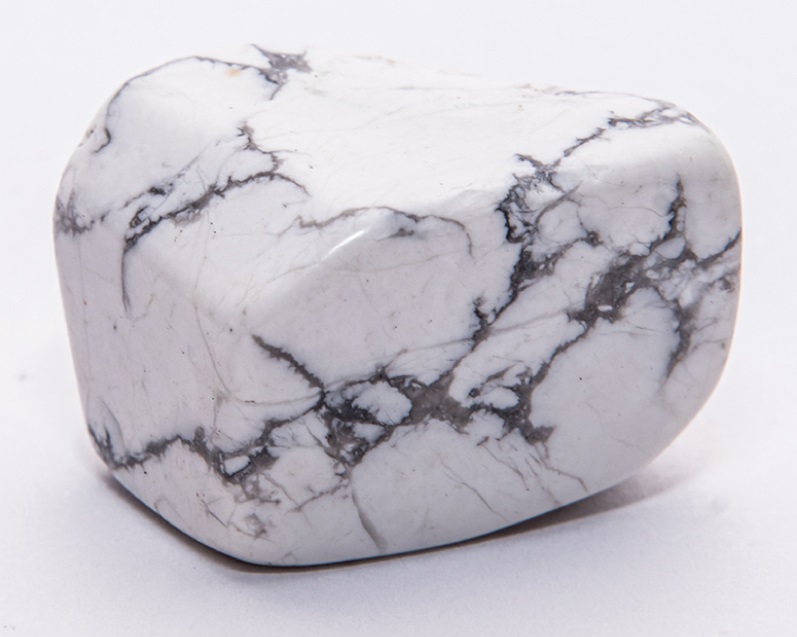
Howlite Varieties and Sources
- Natural Howlite: Natural howlite refers to howlite that is found and mined directly from its natural geological formations. It is the purest form of howlite and retains its inherent properties and characteristics. Natural howlite is primarily sourced from Canada, particularly from deposits in Nova Scotia.
- Treated and Enhanced Howlite: Howlite is a relatively soft and porous mineral, making it susceptible to various treatments and enhancements. It is common for howlite to be dyed to imitate other gemstones or enhance its appearance. Dye treatments can produce a wide range of colors, including blue, green, purple, and other vibrant hues. Treated and enhanced howlite can be found in jewelry and decorative items.
- White Turquoise: White turquoise, sometimes referred to as white buffalo turquoise, is a trade name used for white or light-colored howlite that has been dyed to resemble turquoise. It is often veined or webbed to mimic the appearance of natural turquoise. White turquoise is primarily used in jewelry making.
- Magnesite: Magnesite is a mineral that bears a close resemblance to howlite in terms of appearance. It is often white or grayish-white and displays a porous texture. While magnesite and howlite have similar visual characteristics, they have different chemical compositions. Magnesite is composed of magnesium carbonate (MgCO3), while howlite is a calcium borosilicate hydroxide. Magnesite is sourced from various locations worldwide, including Austria, China, and the United States.
- Marble: In certain instances, white or grayish-white marble can bear a resemblance to howlite. Marble is a metamorphic rock composed primarily of calcite or dolomite minerals. It is widely used in construction and sculpting due to its beauty and durability. However, it should be noted that marble and howlite are distinct minerals with different compositions and properties.
As for sources, Canada, particularly Nova Scotia, remains the primary and most significant source of natural howlite. It is where the mineral was first discovered and where significant deposits are found. Howlite can also be found in other countries, including the United States (California, Nevada), Mexico, Germany, and Russia. These sources contribute to the availability and global distribution of howlite and its various forms.

Popular sources and mining locations
- Canada: Canada is the primary and most well-known source of howlite. The mineral was first discovered in Nova Scotia, Canada, by Henry How, the geologist after whom it was named. Nova Scotia remains a significant mining location for howlite, with deposits in various areas of the province.
- United States: Howlite can be found in certain regions of the United States. The most notable locations include California and Nevada. California is known for its deposits of white howlite, particularly in the desert areas of Riverside and San Bernardino counties. Nevada, specifically the Lander County and Esmeralda County areas, also yields howlite.
- Mexico: Mexico is another notable source of howlite. The country has deposits of this mineral, particularly in the state of Baja California Sur. Howlite from Mexico is often sought after for its quality and unique characteristics.
- Germany: Howlite deposits can be found in Germany, primarily in the state of Saxony. The region around Schneeberg is known for its production of howlite, which has been used in ornamental carvings and jewelry.
- Russia: Russia is also a source of howlite. The Ural Mountains region, specifically the areas around the city of Ekaterinburg, has produced howlite specimens. Russian howlite is appreciated for its quality and distinct appearance.
These locations represent some of the well-known sources of howlite, but it is important to note that howlite can also be found in smaller quantities in other countries and regions around the world. Mining operations in these locations extract howlite from the earth and process it for various applications, including jewelry making, ornamental objects, and industrial uses.
Uses of Howlite
Howlite has a range of uses in various industries and applications. Here are some common uses of howlite:
- Jewelry: Howlite is a popular gemstone used in jewelry making. Its white or grayish-white color, along with its unique veining and porosity, make it an attractive choice for beads, cabochons, pendants, and other jewelry components. Howlite can be shaped, polished, and incorporated into necklaces, bracelets, earrings, and rings.
- Ornamental Objects: Howlite’s distinctive appearance and natural beauty make it suitable for ornamental objects. It can be carved into figurines, sculptures, decorative bowls, and vases. Howlite’s porous nature can also make it suitable for diffusing essential oils or fragrances when used as a decorative piece.
- Beads and Craft Supplies: Howlite beads, both natural and dyed varieties, are commonly used in beaded jewelry designs. They are available in various shapes and sizes, providing versatility for artisans and crafters. Howlite beads can be used in beaded bracelets, necklaces, and other craft projects.
- Cabochons and Cameos: Howlite is often shaped into cabochons, which are polished, non-faceted gemstones with a smooth, rounded top. These cabochons can be set into rings, pendants, and brooches. Howlite’s veining and color variations can create interesting and unique patterns when used in cameo carvings.
- Industrial Applications: Due to its relatively soft nature, howlite is sometimes used as a filler material in industrial applications. It can be used as a component in ceramics, pottery, and casting materials.
- Gemstone Substitution: Howlite has been used as a substitute for more expensive gemstones, such as turquoise and coral. Its white color and porous structure make it a viable alternative, especially when dyed to resemble other gemstones.
It’s important to note that while howlite is widely used for its aesthetic and metaphysical properties, its usage may vary based on cultural and individual preferences. Whether for adornment, spiritual purposes, or industrial applications, howlite offers a versatile and visually appealing mineral for various creative and practical endeavors.
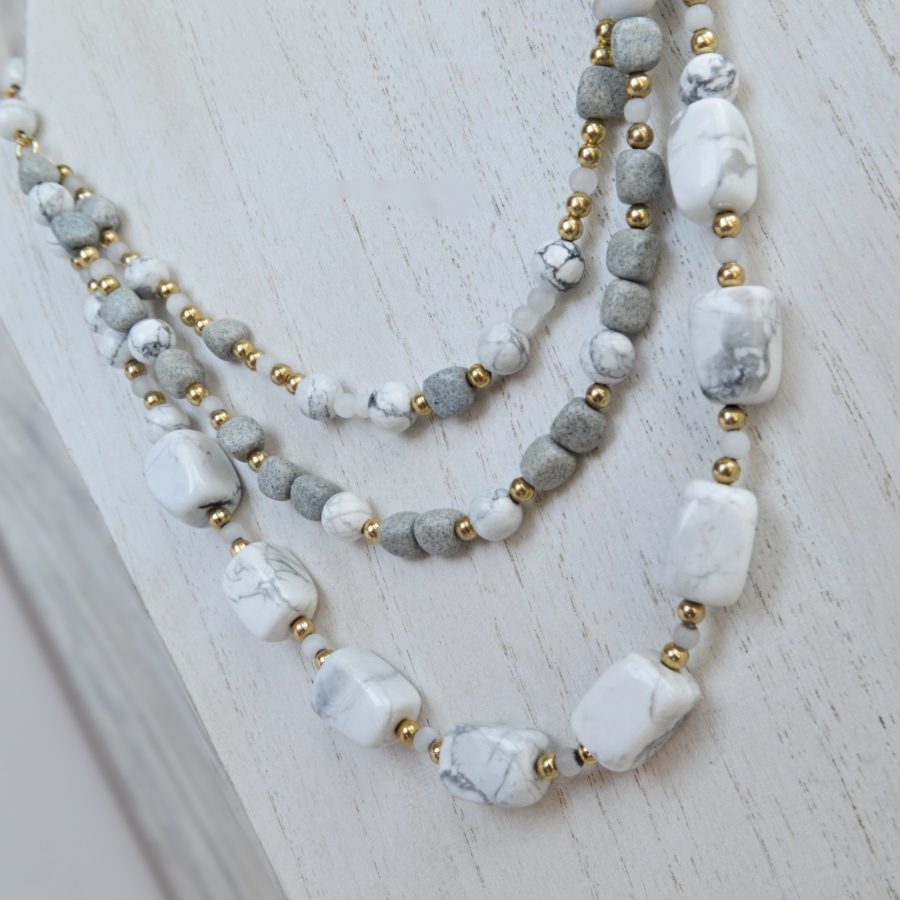
Howlite in Gemology and Jewelry
Howlite plays a significant role in gemology and jewelry due to its unique appearance and properties. Here’s a closer look at howlite in the context of gemology and its use in jewelry:
- Gemstone Classification: Howlite is classified as a gemstone in the field of gemology. It is recognized and studied alongside other minerals and gemstones for its distinct characteristics, such as its chemical composition, crystal structure, and optical properties.
- Gemstone Identification: Gemologists and gemstone experts use various methods to identify and differentiate howlite from other gemstones. These methods include visual examination, refractive index measurement, specific gravity determination, and sometimes advanced techniques like spectroscopy or X-ray diffraction.
- Cabochons and Beads: Howlite is commonly cut and shaped into cabochons, which are smooth, polished gemstones with a rounded top and a flat bottom. Cabochons showcase the veining and patterns of howlite, creating visually appealing jewelry pieces. Howlite cabochons can be set into rings, pendants, earrings, and other jewelry designs.
- Carvings and Cameos: Due to its relatively soft nature, howlite is suitable for carving into intricate designs and cameos. Skilled artisans can sculpt howlite into detailed figurines, decorative objects, or even portrait cameos, taking advantage of its unique color patterns and porous texture.
- Beads and Bracelets: Howlite beads, both natural and dyed varieties, are widely used in beaded jewelry. They can be incorporated into bracelets, necklaces, and anklets, either as standalone beads or combined with other gemstones or materials to create visually appealing and meaningful designs.
- Dyeing and Color Enhancement: Howlite is often dyed to imitate other gemstones or to enhance its visual appeal. Dye treatments can produce a wide range of colors, including blue, green, purple, and other vibrant hues. Dyed howlite beads and cabochons are popular choices for jewelry designers looking to achieve specific color schemes or mimic the look of more expensive gemstones.
When working with howlite in jewelry, it’s important to consider its relative softness compared to other gemstones. Due to its hardness ranging from 3.5 to 6 on the Mohs scale, howlite can be susceptible to scratching and abrasion, and it should be handled and stored with care to maintain its appearance and durability.
Overall, howlite’s unique appearance, versatility, and spiritual associations make it a popular choice for gemologists, jewelry designers, and individuals seeking gemstone jewelry with aesthetic and metaphysical qualities.
Howlite and its Similars Stones
Howlite bears similarities to several other stones in terms of appearance, color, or texture. While these stones may share some visual or structural characteristics with howlite, it’s important to note that they have distinct compositions and properties. Here are some stones that are often compared to or mistaken for howlite:
- White Magnesite: White magnesite closely resembles howlite in terms of color and texture. It is often white or grayish-white with gray veining, giving it a similar appearance to howlite. However, magnesite is chemically composed of magnesium carbonate (MgCO3), while howlite is a calcium borosilicate hydroxide. Magnesite is generally softer than howlite and has a Mohs hardness of around 3.5 to 4.5.
- White Marble: Certain types of white marble can resemble howlite due to their white or grayish-white color and occasional veining. Marble is a metamorphic rock primarily composed of calcite or dolomite minerals. While marble and howlite may share visual similarities, they have different chemical compositions and physical properties. Marble is much harder than howlite, ranging from 3 to 5 on the Mohs scale.
- White Quartzite: White quartzite is another stone that can bear resemblance to howlite. It is a metamorphic rock formed from sandstone and composed mainly of quartz. White quartzite can have a similar white or grayish-white color with occasional veining. However, quartzite is significantly harder than howlite, with a Mohs hardness of 7.
- White Chalcedony: White chalcedony is a form of microcrystalline quartz that can resemble howlite in terms of color and texture. It often appears as a translucent or opaque white stone with a waxy or vitreous luster. While white chalcedony may share a similar appearance with howlite, it has a different chemical composition and is much harder, ranking 6.5 to 7 on the Mohs scale.
When it comes to distinguishing these stones from howlite, it’s important to consider their properties, including hardness, specific gravity, and chemical composition. Laboratory tests or consultation with gemological experts can help accurately identify and differentiate these stones from genuine howlite.
While these similar stones may not have the exact properties or metaphysical associations as howlite, they can still be utilized in jewelry or decorative objects for their own unique qualities and aesthetic appeal.
Notable discoveries and famous specimens
While howlite is not typically associated with notable discoveries or famous specimens like some other gemstones, it has gained recognition for its beauty and use in jewelry and ornamental objects. However, there are a few notable mentions related to howlite:
- Discovery by Henry How: Howlite was first discovered and described by Henry How, a Canadian geologist, in 1868. He found the mineral in Nova Scotia, Canada, and named it after himself. This initial discovery and naming of howlite by its founder are noteworthy events in its history.
- Carving and Use in Artifacts: Howlite has been used for carving ornamental objects and artistic pieces. Skilled artisans have crafted intricate figurines, decorative bowls, and other objects from howlite. While there may not be specific famous artifacts or sculptures made exclusively from howlite, the craftsmanship and artistic value associated with howlite carvings are recognized and appreciated.
- Use in Jewelry and Designer Collections: Howlite has found its way into the creations of renowned jewelry designers and brands. Jewelry pieces featuring howlite cabochons, beads, or carvings have been showcased in various collections. While not specifically famous on their own, these designer pieces contribute to the overall recognition and popularity of howlite in the jewelry industry.
It’s important to note that howlite is primarily valued for its beauty and aesthetic qualities rather than for specific famous discoveries or individual specimens. Its use in jewelry, ornamental objects, and artistic creations highlights its appeal as a gemstone and its ability to enhance various artistic expressions.
Summary of key points
- Howlite is a calcium borosilicate hydroxide mineral known for its white or grayish-white color with gray veining or marbling.
- It is primarily found in Canada, particularly in Nova Scotia, where it was first discovered by Henry How, the geologist after whom it was named.
- Howlite can also be found in other countries, including the United States (California, Nevada), Mexico, Germany, and Russia.
- It has a relatively soft hardness of 3.5 to 6 on the Mohs scale, making it suitable for carving, cabochons, and beads.
- Howlite has a porous texture and can be dyed to imitate other gemstones or enhance its appearance, resulting in a wide range of colors.
- In terms of chemical composition, howlite is a calcium borosilicate hydroxide with the chemical formula Ca2B5SiO9(OH)5.
- Optically, howlite is typically opaque with a vitreous to pearly luster and a white streak.
- Howlite is often used in jewelry making, including as cabochons, beads, and cameos. It is also used in ornamental objects, carvings, and beads for craft projects.
- It is associated with calming and soothing energies, making it popular in spiritual and metaphysical practices.
- Howlite is sometimes mistaken for other stones such as white magnesite, white marble, white quartzite, or white chalcedony, which may share visual similarities but have different compositions and properties.
- While there are no specific famous discoveries or specimens associated with howlite, its use in jewelry and ornamental objects has gained recognition and appreciation.
Overall, howlite is a versatile and visually appealing mineral with a range of uses in jewelry, crafts, and spiritual practices. Its distinctive appearance, calming properties, and availability make it a popular choice for various applications.
Final thoughts on howlite’s importance
In conclusion, howlite holds importance in several aspects:
- Aesthetic Appeal: Howlite’s unique appearance, characterized by its white or grayish-white color and distinctive veining, makes it visually appealing. It is often used in jewelry and ornamental objects for its beauty and ability to add a touch of elegance to designs.
- Versatility: Howlite’s versatility allows it to be shaped into various forms, such as cabochons, beads, carvings, and cameos. This adaptability makes it suitable for different jewelry-making techniques and artistic expressions.
- Affordability: Howlite provides an affordable alternative to more expensive gemstones. Its availability and comparatively lower cost make it accessible to a wider range of individuals, allowing them to enjoy the beauty of a gemstone without breaking the bank.
- Spiritual and Metaphysical Properties: Howlite is associated with calming and soothing energies. It is believed to aid in emotional healing, stress reduction, and spiritual growth. Its metaphysical properties make it a popular choice among those seeking inner peace and balance.
- Cultural Significance: Howlite’s historical significance, including its discovery by Henry How and its use in various cultural practices, adds to its overall importance. It has been utilized in artistic and spiritual traditions, connecting it to cultural heritage and symbolism.
While howlite may not have the same level of recognition or fame as some other gemstones, its significance lies in its accessibility, versatility, and ability to bring beauty and positive energy into people’s lives. Whether in jewelry, art, or spiritual practices, howlite offers a unique and affordable option for those seeking its distinct qualities and charm.
FAQ
How is howlite formed?
Howlite is formed through hydrothermal processes in metamorphic and igneous environments. It is often found in boron-rich environments, where it crystallizes in cavities and fractures in rock formations.
What are the primary minerals associated with howlite?
Howlite is commonly associated with minerals such as quartz, feldspar, calcite, pyrite, and various boron-bearing minerals. These minerals are often found in the same geological settings as howlite.
What is the geological age of howlite deposits?
Howlite deposits can vary in geological age depending on their specific location. In Nova Scotia, Canada, where the mineral was first discovered, the deposits are of Carboniferous age, around 350-300 million years old. However, howlite can also be found in younger or older geological formations in different regions.
What are the main geological locations where howlite is found?
The main geological locations for howlite include Nova Scotia in Canada, California and Nevada in the United States, Mexico, Germany (Saxony), and Russia (Ural Mountains region). These regions have notable howlite deposits and mining operations.
What geological processes are involved in the formation of howlite?
Howlite is typically formed through hydrothermal processes, where hot fluids carrying dissolved minerals penetrate rock formations and precipitate minerals, including howlite, in fractures and cavities. Metamorphic processes can also contribute to the formation of howlite when existing minerals undergo changes due to heat and pressure.
Are there any specific rock types associated with howlite?
Howlite is commonly found in association with volcanic and sedimentary rocks. It is often found in cavities and veins within these rock types. It can also occur in metamorphic rocks that have undergone recrystallization and hydrothermal alteration.
Can howlite be found in gemstone deposits?
While howlite is not typically classified as a gemstone, it is sometimes used in jewelry due to its aesthetic qualities. It is more commonly found in industrial mineral deposits or as a byproduct of other mining operations.




































